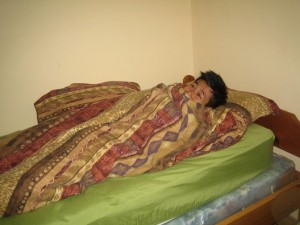Bed sores are cuts, lesions or swelling due to prolonged pressure on any part of the body and usually affects bony regions of the body.
Bed sores usually happens on handicapped, disabled, paralyzed or bed ridden people since they are not capable of changing positions frequently. Continuous pressure on specific areas of the body can result to bed sores.
Bed sores develop on the heels, buttocks, lower back and the hip bone area on bed ridden people. The areas of the body such as the spine, ankles, knees, shoulders and the head are prone to develop bedsores and depend on the fixed position of the person.
Symptoms
Stage 1
- The skin is intact, even in the initial stages.
- With light skinned individuals, the skin is darker and does not lighten when touched

Bed sores develop on the heels, buttocks, lower back and the hip bone area on bed ridden people. - With dark skinned individual, there is no change in the actual color of skin, but there is presence of bluish or purple spots
- Softness, pain, tenderness and changes in temperature around the skin.
Stage 2
- Development of ulcers or open wounds
- Damage to the underlying layer of the dermis and the epidermis
- Ruptured blisters that are filled with fluid can be found on the skin.
- A pinkish, shallow and basin-like wounds
Stage 3
- Development of deep wound at the affected area.
- Crater-like ulcers on the skin
- Skin loss and exposing fat
Causes
- A sustained pressure such as some underlying tissues trapped between the bones and a hard surface such as a bed frame or a wheelchair. The pressure applied to this area is higher than the blood pressure that runs through the capillaries.
- When two surfaces are moving in opposite direction that is common in people using elevated hospital beds for long periods of time. The patient slides down the bed through the tailbone and the skin above the tailbone remains intact and results to a damaged blood vessels and tissues.
- Resistance to motion is a common problem among patients who are handled and moved around with the help of a caregiver and if the skin of the patient is moist, friction can cause severe damage.
Treatment
- The wound should be cleaned properly in order to prevent infection and inflammation. Use fresh water and mild soap in cleaning bed sores. If there is an open sore, use salt water or saline solution to clean the wounds at least several times every day.
- Dress the wound in order to prevent infection and keep the area dry. Use gauzes such as gel foams, treated bandages and films.
- Perform some exercises that are suited to the capabilities of a particular patient.
- Quit smoking in order to prevent bed sores. Smoking affects the blood circulation, oxygen and delivery of nutrients to the skin.
- The best way to protect the bony areas of the body is to sleep in a soft mattress or an air mattress to promote fast healing of the bed sores.
